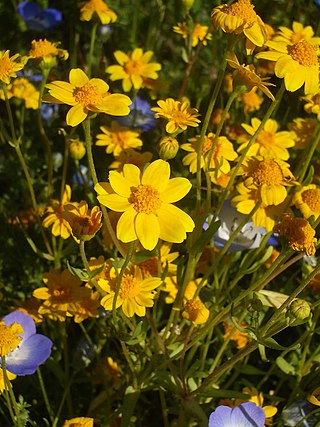
Lasthenia, commonly known as goldfields, is a genus of flowering plants family Asteraceae. The genus is named after Lasthenia of Mantinea, a cross-dressing female pupil of the ancient Greek philosopher Plato.

Lasthenia burkei is a rare species of flowering plant in the family Asteraceae known by the common names Burke's goldfields and Burke's baeria.

Lasthenia californica is a species of flowering plant in the family Asteraceae known by the common name California goldfields. It is native to western North America.
Lasthenia chrysantha is a species of flowering plant in the family Asteraceae known by the common name alkalisink goldfields. It is endemic to the California Central Valley, where it grows in vernal pools and alkali flats.

Lasthenia coronaria is a species of flowering plant in the family Asteraceae known by the common name royal goldfields. It is native to California and Baja California, including Guadalupe Island.

Lasthenia ferrisiae is a species of flowering plant in the family Asteraceae known by the common name Ferris' goldfields. It is endemic to the California Central Valley, where it grows in vernal pools and alkali flats.

Lasthenia fremontii is a species of flowering plant in the family Asteraceae known by the common name Frémont's goldfields. It is endemic to the California Central Valley, where it grows in vernal pools and meadows.
Lasthenia glaberrima is a species of flowering plant in the family Asteraceae known by the common names smooth goldfields and rayless goldfields. It is native to western North America from British Columbia to California, where it grows in wet meadows and vernal pools.

Lasthenia glabrata is a North American species of flowering plant in the family Asteraceae known by the common names yellowray goldfields and yellow-rayed lasthenia. It is endemic to California, where it is a resident of vernal pools and other moist areas in a number of habitat types. It is widespread across much of the state, from San Diego County to Tehama County.
Lasthenia microglossa is a species of flowering plant in the family Asteraceae known by the common name smallray goldfields. It is endemic to California, where it grows in shady areas in a number of habitats.
Lasthenia minor is a species of flowering plant in the family Asteraceae known by the common name coastal goldfields. It is endemic to California, where it is a resident of coastal and inland grassland habitat.

Symphyotrichum frondosum is a species of flowering plant in the family Asteraceae native to western North America. Commonly known as short-rayed alkali aster, it is an annual or perennial herbaceous plant that may reach 140 centimeters tall.

Almutaster is a North American genus of plants in the family Asteraceae containing the single species Almutaster pauciflorus, which is known by the common name alkali marsh aster. It is native to Canada, the Western United States, and northern and central Mexico. The genus is named for botanist Almut Gitter Jones.
Blennosperma bakeri is a rare species of flowering plant in the daisy family known by the common names Baker's stickyseed and Sonoma sunshine.

Lasthenia maritima is a species of flowering plant in the family Asteraceae known by the common names maritime goldfields and seaside goldfields.
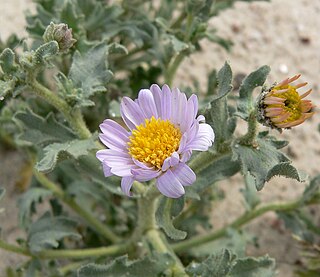
Arida arizonica,, is an annual plant in the, known by the common names arid tansyaster, desert tansyaster, and Silver Lake daisy. It is native to the very arid deserts of northern Mexico and the southwestern United States, and usually looks straggly and not very attractive. But in years with very heavy rainfall, it fills out and becomes rounded and bush like.

Pyrrocoma lanceolata is a species of flowering plant in the family Asteraceae known by the common name lanceleaf goldenweed. It is native to western North America from central Canada to northeastern California to Colorado, where it grows in many types of habitat, including disturbed places and areas with wet, alkali soils. It is a widespread and variable plant. It is a perennial herb growing one or more stems up to about half a meter long. The stems are decumbent or upright, reddish, usually somewhat hairy to quite woolly, and glandular toward the ends of the stems. The largest leaves are at the base of the plant, each measuring up to 30 centimeters in maximum length. They are generally lance-shaped with sawtoothed edges. The inflorescence bears several, up to 50, flower heads lined with reddish to green phyllaries. Each contains yellow disc florets and ray florets. The fruit is an achene up to a centimeter long including its pappus.
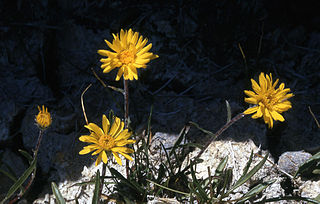
Pyrrocoma uniflora is a species of flowering plant in the family Asteraceae known by the common name plantain goldenweed. It is native to western North America from central Canada to California to Colorado, where it grows in several types of habitat, including forest and meadows with alkali soils, such as those near hot springs. It is a perennial herb growing up to 40 centimeters tall, the stems reddish and usually with a thin to thick coating of woolly fibers. The lance-shaped, toothed leaves are usually woolly, the largest near the base of the plant reaching up to 12 centimeters in length. The inflorescence is a single flower head or a cluster of a few heads, each lined with woolly phyllaries. The head contains yellow disc and ray florets. The fruit is an achene which may be over a centimeter long including its long pappus.
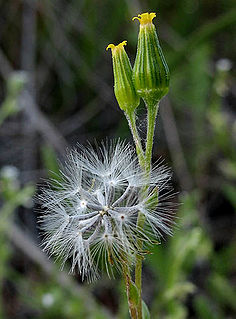
Senecio aphanactis, known by the common names chaparral ragwort, rayless ragwort, and California groundsel, is a species of flowering plant in the aster family.
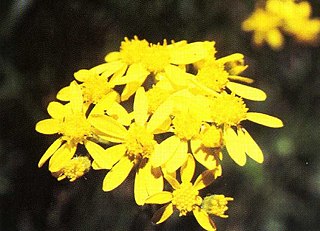
Senecio hydrophilus is a species of flowering plant in the aster family known by the common names water ragwort and alkali-marsh ragwort. It is native to western North America from British Columbia to California to Colorado, where it grows in swampy places such as marshes. It can grow in standing water, including alkaline and salty water. It is a biennial or perennial herb producing a single erect stem or a cluster of a few stems which may exceed one meter in maximum height, at times approaching two meters. The stem is hollow, waxy in texture, and often pale green in color, and it emerges from a small caudex. The thick leaves are lance-shaped to oval with smooth or toothed edges, the blades up to 20 centimeters long and borne on petioles. Smaller leaves occur farther up the stem. The inflorescence is one or more large, spreading clusters of many flower heads. They contain many yellowish disc florets at the center and sometimes have small yellow ray florets as well.













